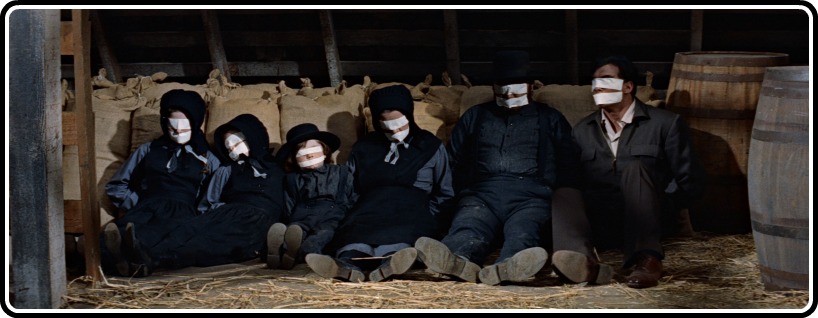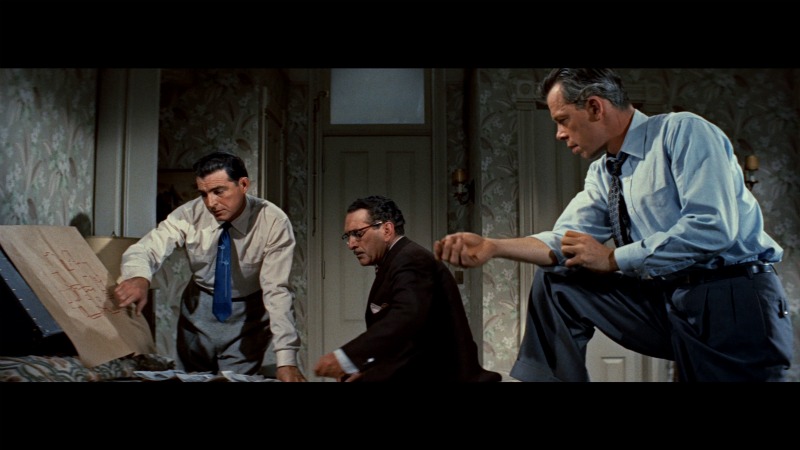
Film noir and melodrama are really two sides of the same coin – they allow a familiar outlet for feelings of regret, longing, existential despair, and mourning that which we cannot change. Both genres flourished in the U.S. during the postwar era, when Americans were being assured that victory meant prosperity, but perhaps not finding that either guaranteed happiness. The two were combined several times in the 1950s (Nicolas Ray did this particularly well), but never perhaps more blatantly and expertly as what Richard Fleischer accomplished with 1955’s Violent Saturday.
Shot in CinemaScope and DeLuxe Color, the film certainly feels, aesthetically, more akin to Douglas Sirk than Fritz Lang, but it has the latter’s sense of clockwork precision. Hell, it’s a 90-minute film with at least four discrete stories – Shelly (Victor Mature) is ashamed that his son thinks him a coward; Boyd (Richard Egan), his business partner, is struggling, drunkenly, with an unfaithful wife (Margaret Hayes), and considering an affair with a young nurse (Virginia Leith), on whom the local bank manager (Tommy Noonan) has been spying as of late. And across town, a group of bank robbers (Stephen McNally, Lee Marvin, and J. Carrol Naish) are planning a big heist.

Fleischer doesn’t try to pretend as though we’re headed any other direction – clearly, all these people (and more) will find themselves at the bank on that faithful day, and be permanently affected by the outcome. He and screenwriter Sydney Boehm (adapting a novel by William L. Heath) use the robbery to nudge the film along, maintaining a piece of tangible tension that lends a sense of fatalism to the other characters’ private dramas. Will it ultimately matter if Boyd reconciles with his wife, or if Harry’s peeping Tom escapades are discovered? Will Shelly be revealed to be a heroic figure, or crippled by fear? Sin is pervasive in this town. What Violent Saturday ultimately considers is the degree to which one must sin to combat a greater evil, and the moral sacrifice required for even innocents to live in an evil world. The bank robbery becomes a physical expression of their inner turmoil, an explosive outlet for all their repressed trauma.
Harry is not a major character, but there are two scenes involving him that beautifully encapsulate the film’s philosophies. In one, the robbers spot him lurking outside their hotel. Lee Marvin suspects he’s watching them; McNally brushes him off, insisting “it’s just a guy walking his dog.” He’s right, insofar as Harry means them no harm. But Harry is not “just a guy walking his dog” – he’s on his way to gaze at the nurse’s bedroom window as she undresses. He’s not endangering them, but he’s not innocent (and Fleischer is not shy about implicating his audience, allowing us even greater access to gaze upon her). In a later scene, when she discovers his lechery, rather than be horrified and fearful, she simply says, “Hereafter, I’ll pull down my shades.” Harry’s behavior is not Linda’s responsibility, of course, but in the same way we lock our doors to prevent burglary, making a few small adjustments does help one sleep at night.

Superlatives are largely insufficient in describing the quality of this transfer, available now in a new (Region-B locked) Blu-ray (released as part of a Dual-Format edition) from the newly-launched Eureka! Classics line. The colors are not only rich and bold, but have a real sort of density common to film, but not at all unusual for digital transfer of these sort of color films. This is the sort of painstaking work we might expect for The Red Shoes or The Adventures of Robin Hood, but for some mostly-forgotten Richard Fleischer film? We truly live in an age of miracles. Contrast is strong without burying detail, grain is pleasantly present but not inordinate, and the picture all-around is crisp, but hardly over-sharpened. The scenes shot outdoor on location blend beautifully with the studio sets, never giving that appearance of wear-and-tear sometimes incurred by location shooting at the time. It’s as strong a transfer as I’ve ever seen. The film is presented in its original, super-wide aspect ratio of 2.55:1. Screencaps here have been resized and compressed, but should give the general idea.

Eureka! rounds out the release with two special features featuring filmmakers William Friedkin and Nicolas Saada discussing the film, their personal relationships to it, its influence and expression of the era, and its many considerable qualities. These, along with the transfer, were ported over from the Carlotta release, and are very well-produced, picking just the right clips to accompany the voiceover, never feeling like they’re just trying to find a way to pass the time. And, even better, both men have strong, worthwhile insights into the film! The Friedkin piece runs about 21 minutes, with the Saada one clocking in at a cool 28, so there’s a good deal of added value on the disc.
In the accompanying booklet, film critic/programmer Adam Batty does an ace job of placing Violent Saturday within Fleischer’s larger, and extremely varied, career, as well as noting the ways in which it intersects with and diverts from concurrent movements in cinema. They fill it out with the film’s campaign book, a sort of PR curiosity that’s interesting without ever being terribly compelling.
This, along with The War Lord, is the inaugural release for the Eureka! Classics line, and, if it is a sign of things to come, I am extremely excited about this venture. As the major film studios have increasingly lost interest in their back catalogues, it has opened the doors for these independent houses to do some truly outstanding, important work, giving us an eclectic array of films in top-notch quality, and Eureka’s release of Violent Saturday is exemplary of precisely this trend. Highly recommended.




![Bergman Island (The Criterion Collection) [Blu-ray]](https://criterioncast.com/wp-content/uploads/2022/11/bergman-island-the-criterion-collection-blu-ray-400x496.jpg)
![This Is Not a Burial, It’s a Resurrection (The Criterion Collection) [Blu-ray]](https://criterioncast.com/wp-content/uploads/2022/11/this-is-not-a-burial-its-a-resurrection-the-criterion-collection-blu-ray-400x496.jpg)
![Lars von Trier's Europe Trilogy (The Criterion Collection) [The Element of Crime/Epidemic/Europa] [Blu-ray]](https://criterioncast.com/wp-content/uploads/2022/11/lars-von-triers-europe-trilogy-the-criterion-collection-the-element-of-400x496.jpg)
![Imitation of Life (The Criterion Collection) [Blu-ray]](https://criterioncast.com/wp-content/uploads/2022/11/imitation-of-life-the-criterion-collection-blu-ray-400x496.jpg)
![The Adventures of Baron Munchausen (The Criterion Collection) [4K UHD]](https://criterioncast.com/wp-content/uploads/2022/11/the-adventures-of-baron-munchausen-the-criterion-collection-4k-uhd-400x496.jpg)
![Cooley High [Criterion Collection] [Blu-ray] [1975]](https://criterioncast.com/wp-content/uploads/2022/11/cooley-high-criterion-collection-blu-ray-1975-400x496.jpg)